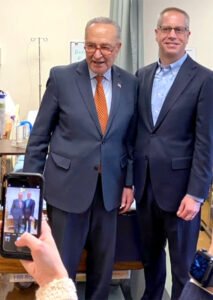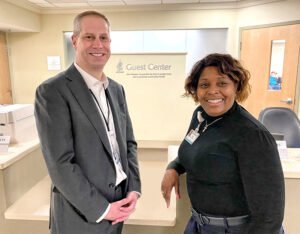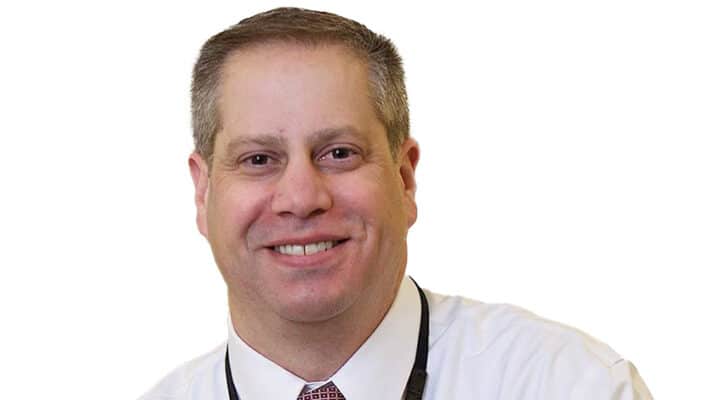Physician Seth Kronenberg, who served as Crouse’s chief medical officer and chief operating officer, is elevated to president and chief executive officer
By Norah Machia

Physician Seth Kronenberg, recently appointed president and chief executive officer for Crouse Health, is no stranger to the hospital.
He was born there, and so were his four daughters. It is where he started his first clinical job, as a pharmacy technician. And his father, physician Paul Kronenberg, served in the same role from 2004 to 2014.
“My father influenced me in becoming a physician; he was a great role model,” said Kronenberg. “I was interested in going into medicine as early as I can remember.”
A board-certified internist, Kronenberg joined Internist Associates of Central New York in 2001 and became managing partner in 2005. In 2010, Internist Associates became part of Crouse Medical Practice, PLLC, and he was appointed medical director. He has been a Crouse-affiliated member of the medical staff for 23 years.
Interestingly, Kronenberg’s daughters have all expressed an interest in careers to help others – particularly in the field of mental health services.
He and his wife, Meredith, have four daughters: Emma, 20, Sara, 18, and twins Brooke and Tess, 15. “We’re an outdoors family, and we enjoy kayaking, hiking, fishing, skiing — anything that keeps us outside,” Kronenberg said.
“I really enjoyed the clinical practice of medicine and doing it fulltime,” said Kronenberg, a University of Pennsylvania graduate who attended medical school and completed his residency at Upstate Medical University.
But in recent years, he has moved away from his clinical work and into administrative positions at Crouse Health. In his current position as president and CEO, Kronenberg has oversight of all operations at Crouse Health.
“Physician leadership was not something I was planning from the beginning,” he said. But different circumstances arose that led to open leadership positions at the hospital that needed to be filled, and “I felt that I could add value to the hospital by serving in them,” Kronenberg said.
Prior to being appointed as Crouse Health’s top executive in March, Kronenberg served as chief medical officer and chief operating officer. He is taking over leadership of Crouse Health as it emerges from the financial and staffing challenges brought on by the COVID-19 pandemic.
Currently, Crouse Health has operating revenue that is exceeding budget, a continued increase in market share and a solid balance sheet. A key focus moving forward will be maintaining and building on this progress, said Kronenberg.
“The pandemic was stressful, but we’re a very resilient organization,” Kronenberg said. “As we come out of the acute phases of COVID, we have refocused on all the things that make Crouse great. We’re very excited about moving forward.”

The approximately 3,200 employees of the healthcare system have played a critical part of the hospital’s recovery from the pandemic, he said. “It’s a new day, and there is a strong sense of pride among employees and physicians at Crouse,” Kronenberg said.
“Our culture is considered to be our greatest asset,” he added. “How we treat each other, our patients and their families. We have created a family environment at Crouse, which also supports our focus on diversity and inclusion.”
In 2022, the total number of patients served by Crouse Health (both inpatient and outpatient) was 625,743.
Crouse is the only “locally governed” hospital in Syracuse, said Kronenberg. Discussions about a proposed merger with Upstate Medical University were recently dropped, and that option is no longer being considered by the two hospitals, he said.
“As one of the region’s leading employers, we take our position as a member of the community seriously, and we’re very proud to provide high quality care and the best patient experience,” Kronenberg said.
Crouse Health has built a strong reputation for a number of specialty services offered to patients in a large geographic region surrounding Central New York.
“We’re a community hospital, but we have a lot of services that differentiate us,” and many have been provided for decades, allowing Crouse Health to emerge as a regional leader, he said.
Crouse offers both inpatient and outpatient addiction treatment services, which started 60 years ago with an outpatient alcoholism clinic, the first of its kind in New York state. It later added a drug clinic, outpatient therapy and inpatient detoxification.
In 2021, Crouse Health moved its outpatient addiction treatment program to a new, larger building on Erie Boulevard East at a time when the opioid drug epidemic was getting worse, both in Central New York and nationwide.
“Crouse is a regional leader in addiction treatment,” said Kronenberg. “We’ve been here for years to meet the needs of the community.” Experienced staff were in place even before the significant increase in drug and alcohol abuse resulting from issues created by the pandemic, including job losses and social isolation.
The neonatal intensive care unit (NICU) at Crouse Health provides the “highest level of care” for premature and critically ill infants with a wide range of specialized services, taking patient referrals from a 15-county region. Crouse is the only hospital in Central New York able to provide this level of sophisticated care and technology.
The care provided to infants, along with their mothers through the regional perinatal program, reflects a continuing hospital tradition.
Crouse was originally started as the Syracuse Women’s Hospital and Training School for Nurses in 1887 and was the only hospital in the area to admit women and children.
The Comprehensive Stroke Center at Crouse Health provides the highest level of stoke care, with a full range of services. The center consistently has the fastest stroke treatment times in the region, Kronenberg said.
Crouse received the distinction of being the first hospital in the region to receive dual certification as a comprehensive stroke center.
The hospital’s emergency room is one of the busiest in the area, said Kronenberg. “It’s impressive what the emergency services department can provide to patients with complex and urgent medical conditions who are seeking care at Crouse, which has a lower wait time than many other facilities in the region,” he said. “This is why we continue to hear patients say, ‘Take me to Crouse.’
Crouse also operates the region’s largest multidisciplinary robotic surgery program, which started in 2008. Since that time, Crouse’s robotic surgery team has completed 15,000 minimally invasive surgical procedures using the da Vinci surgical system, and has grown to focus on urology, colorectal, gynecology, gyn oncology and general surgical procedures.
“We want to make sure people know Crouse is here to stay, and we’re very proud of our service and culture,” Kronenberg said.
Having a physician in the role of top executive at the hospital is a real advantage, said a physician colleague.
“The first thing that comes to mind about Seth is that he is a physician. He’s one of us,” said physician Thomas Hartzheim, Crouse chief of surgery. “Seth understands the relationship between the doctors and the hospital. He is always collaborative, trying to do what is best for all parties.”
This is extremely reassuring, especially over the last few years, which have included the COVID pandemic and Upstate Medical University merger negotiations, his colleague said.
“He has handled these issues exceptionally well, not only dealing with doctors, but also working with other hospitals, local and state government, payors and vendors,” said Hartzheim. “Seth is always visible and always available. He has led us all by example and is the embodiment of the Crouse culture.”
“Seth’s medical background, his lifelong connection to Crouse and the experiences of the last few years makes him uniquely qualified to lead this organization going forward,” he added.

